Charles E W Bean, Diaries, AWM38 3DRL 606/228/1 - Folder - Part 8
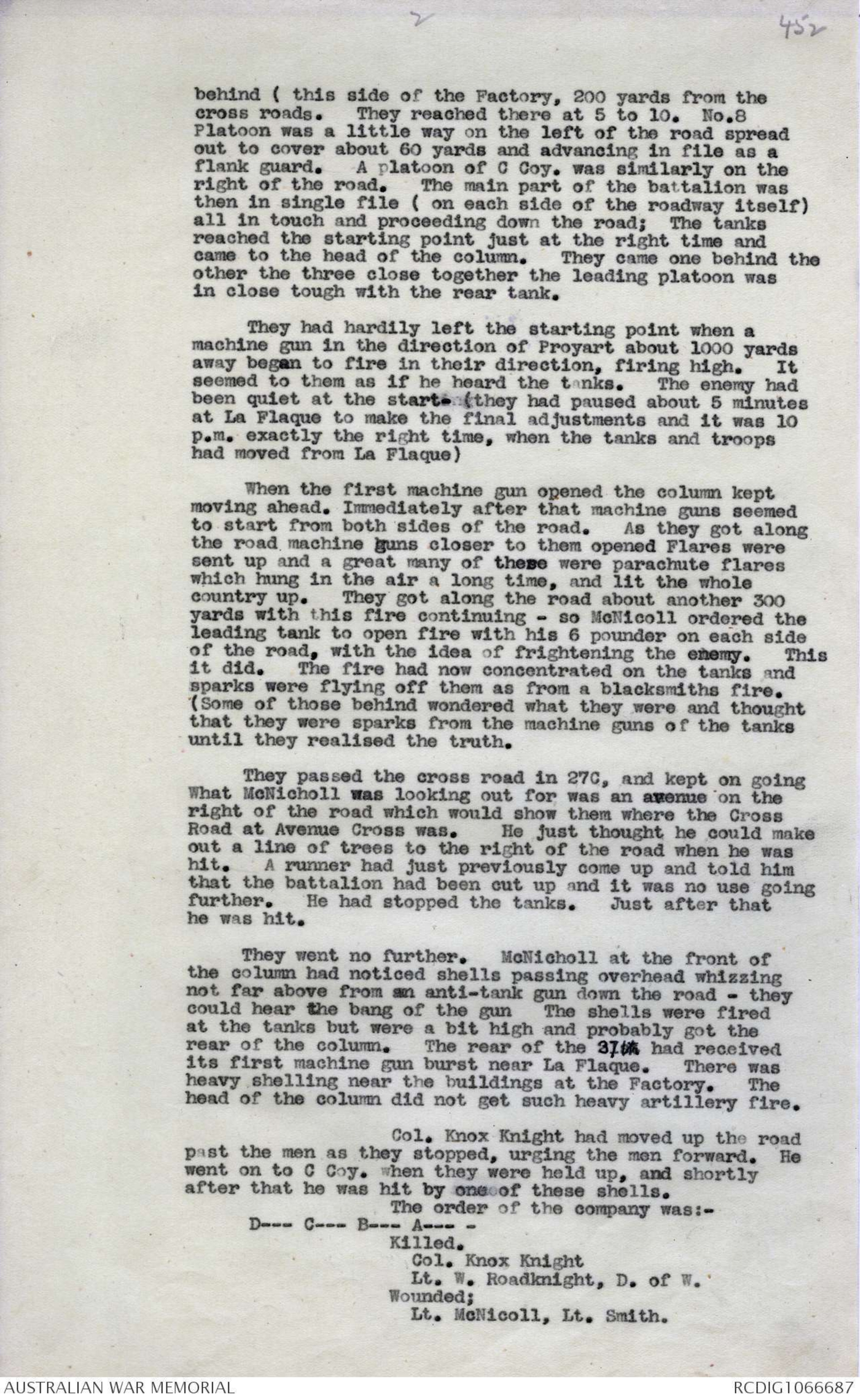
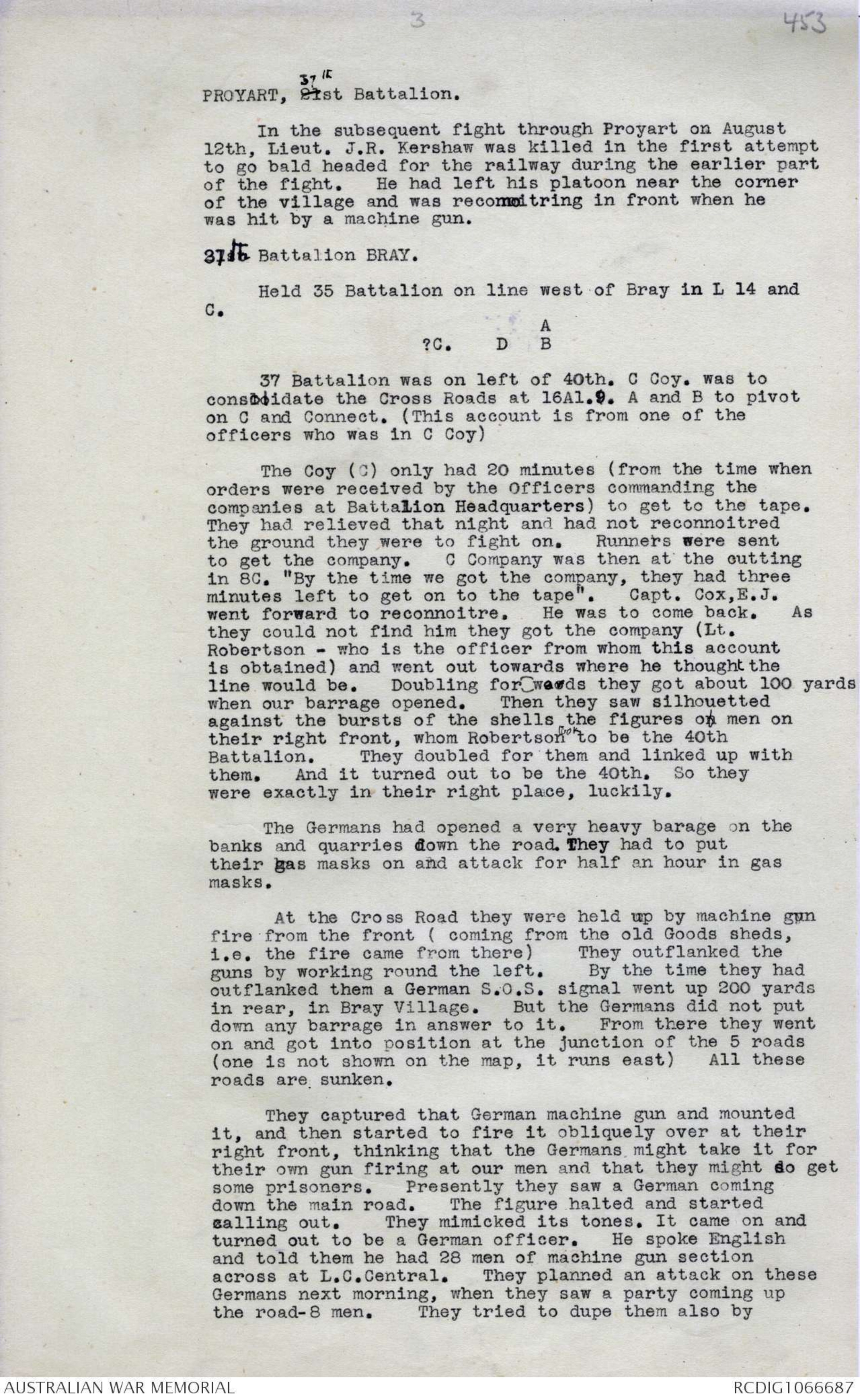
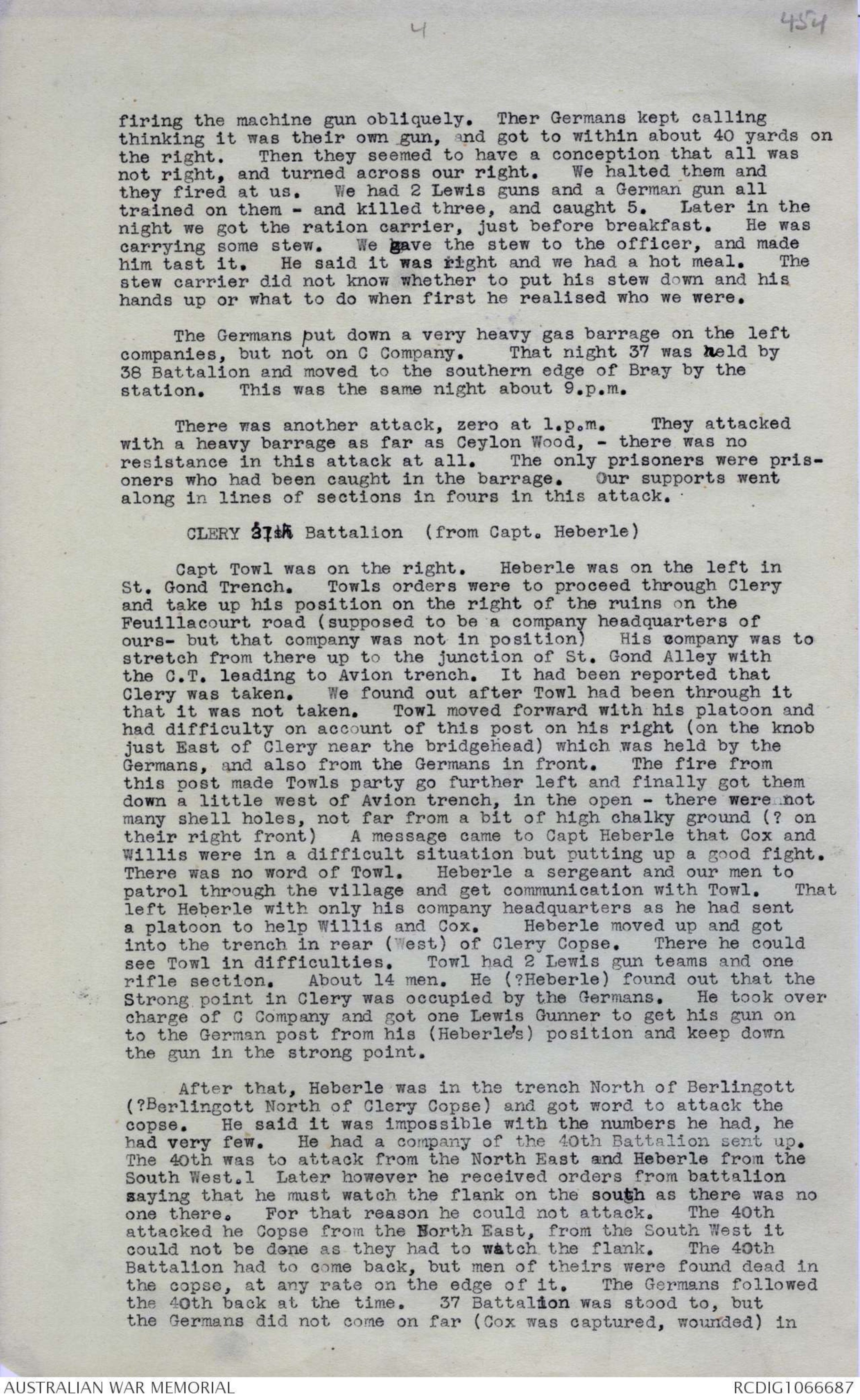
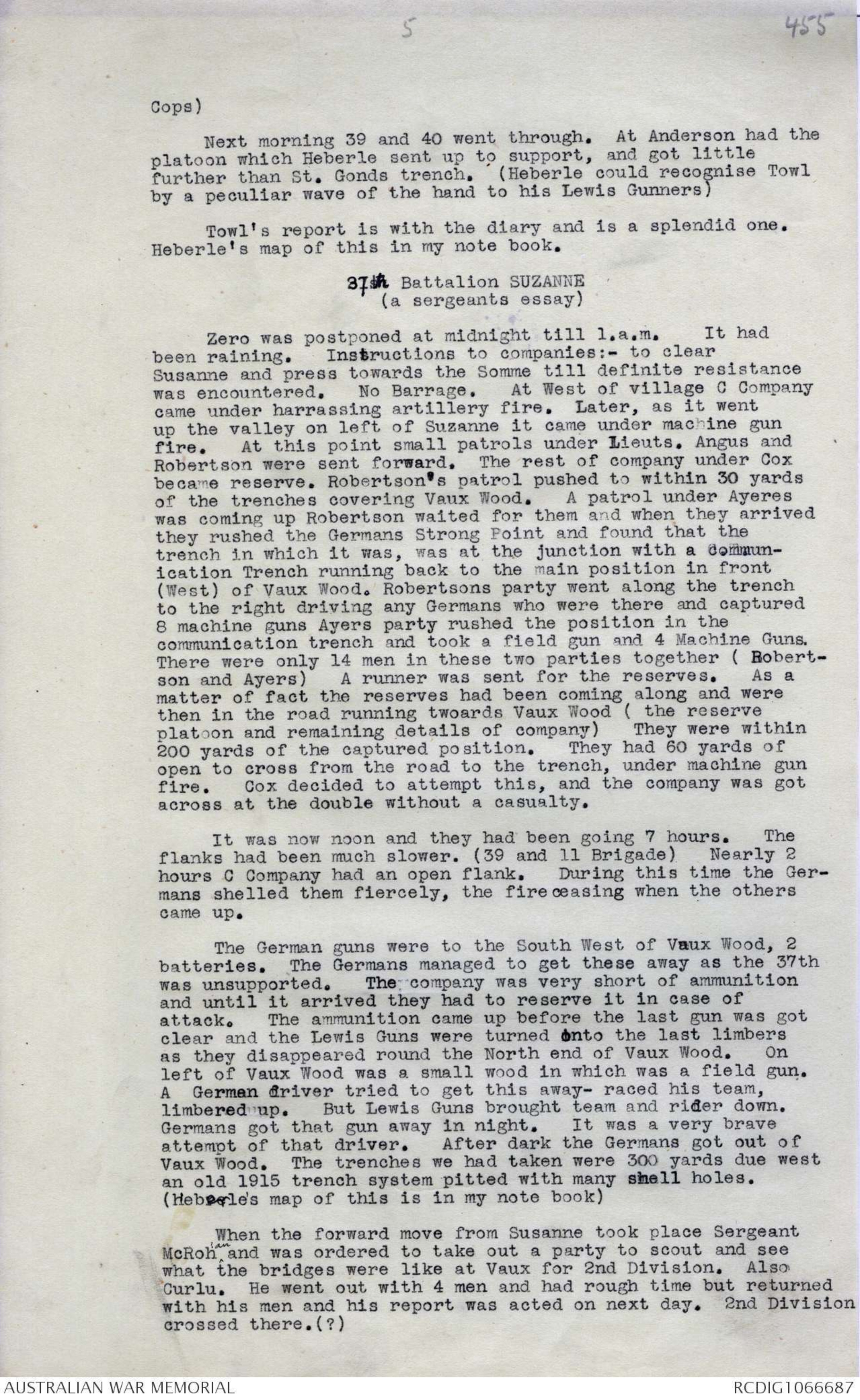
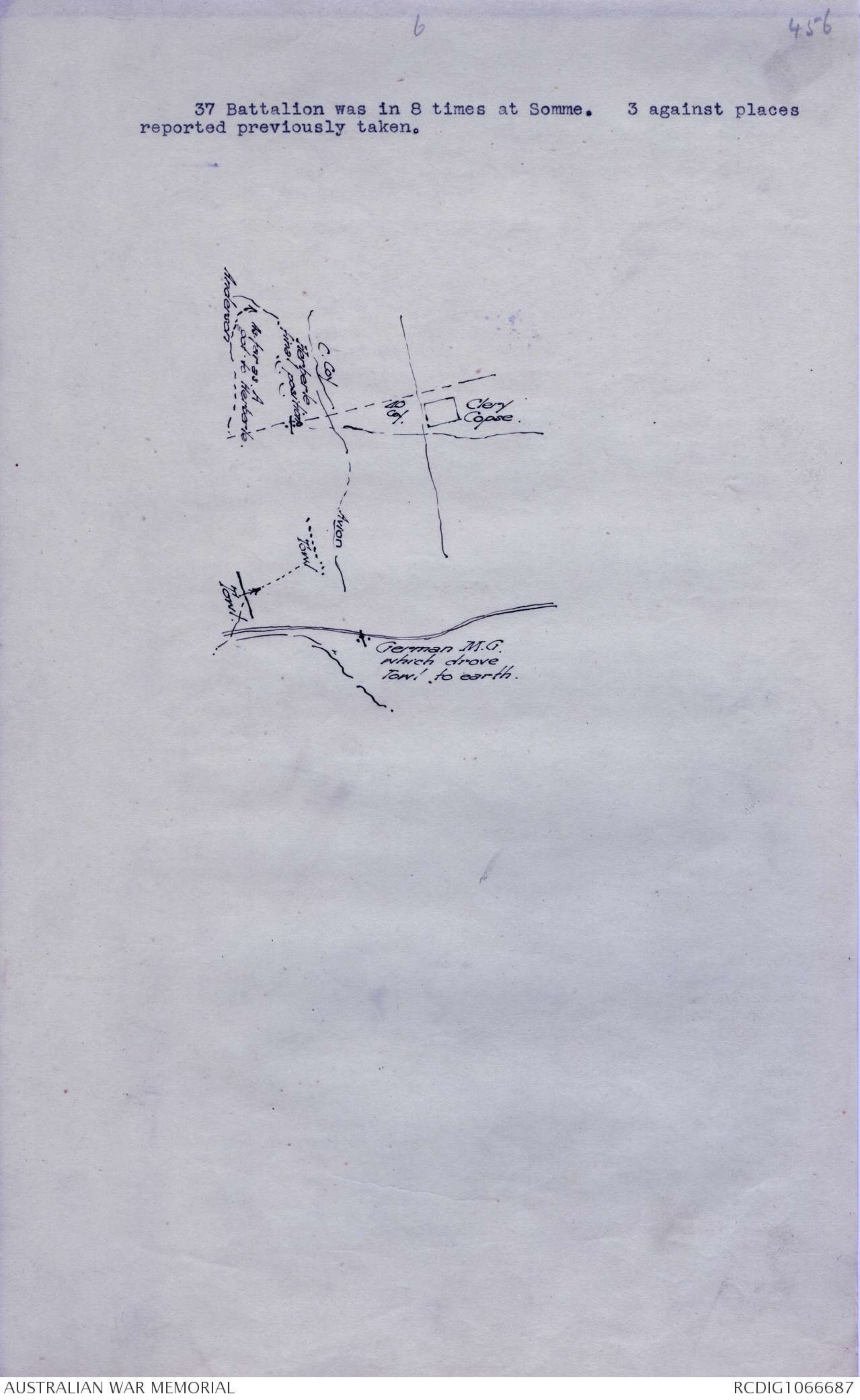
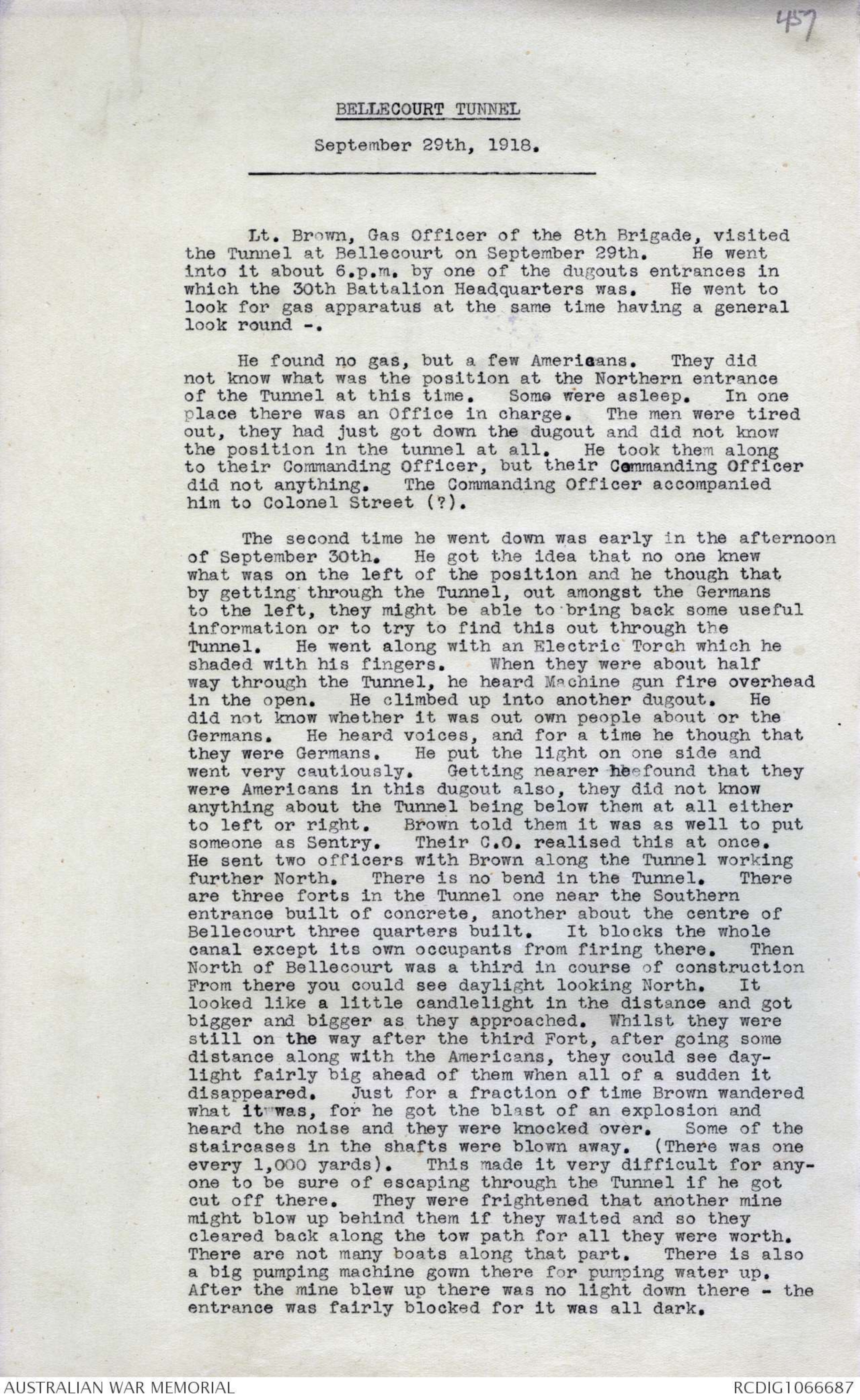
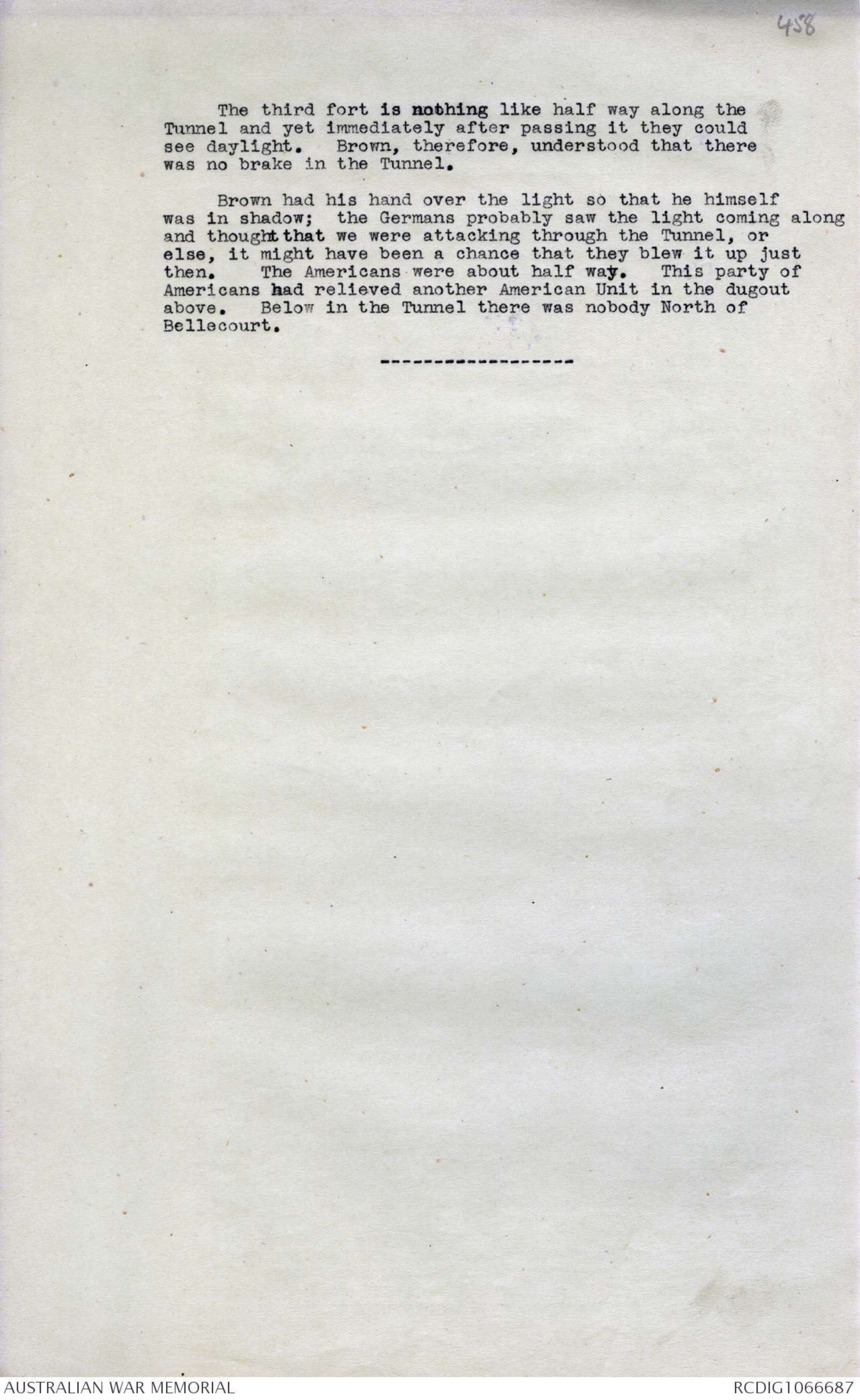
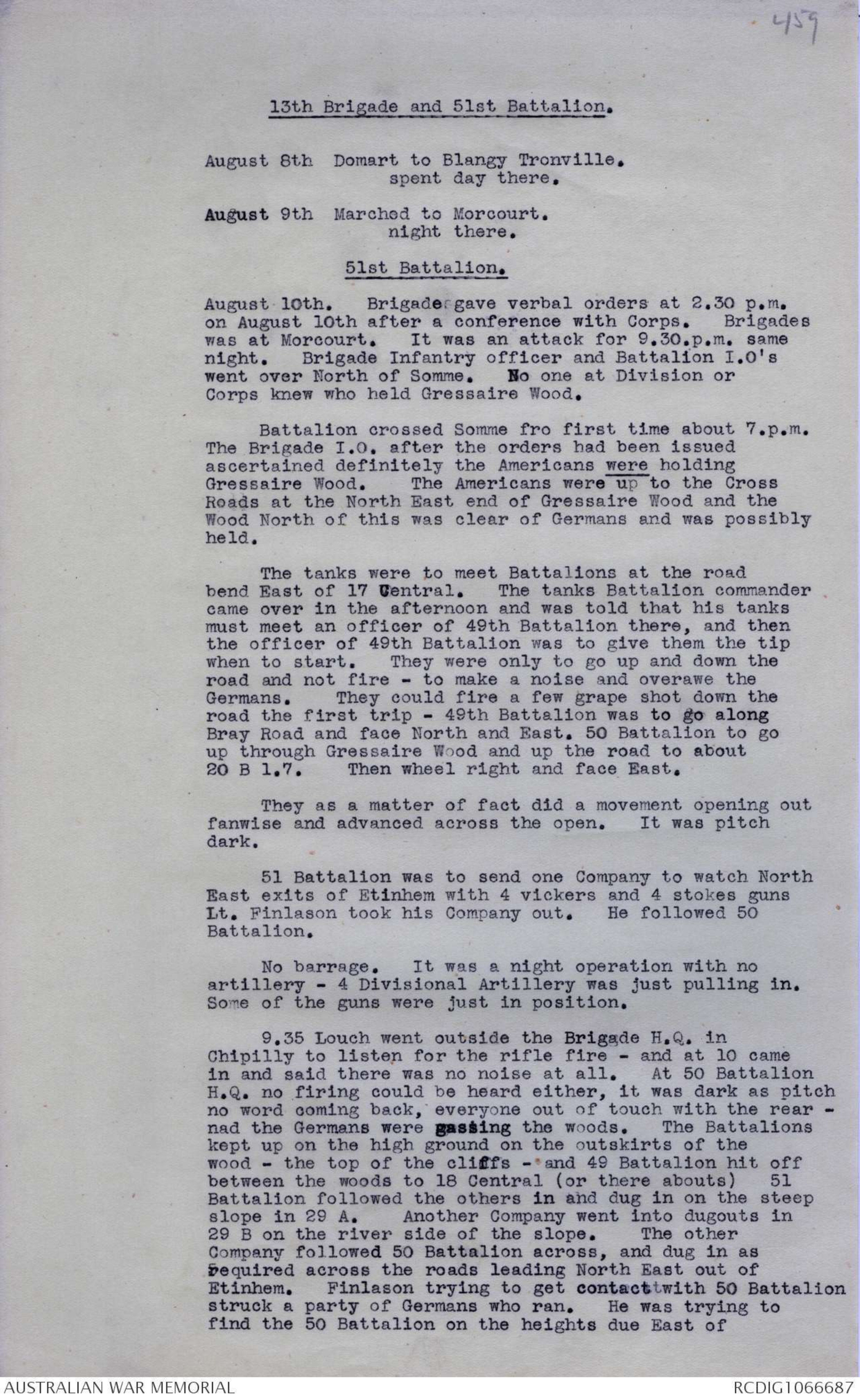
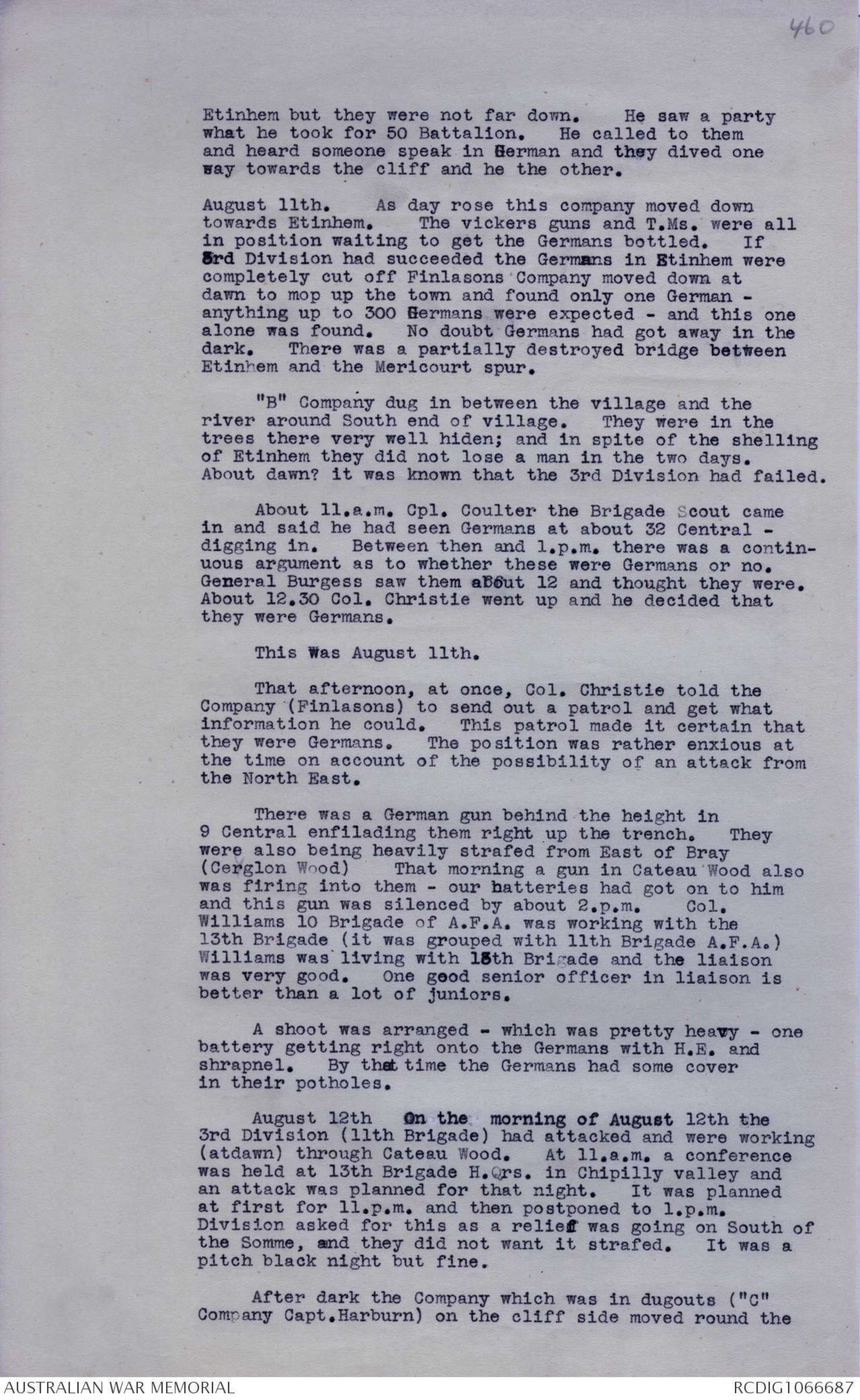
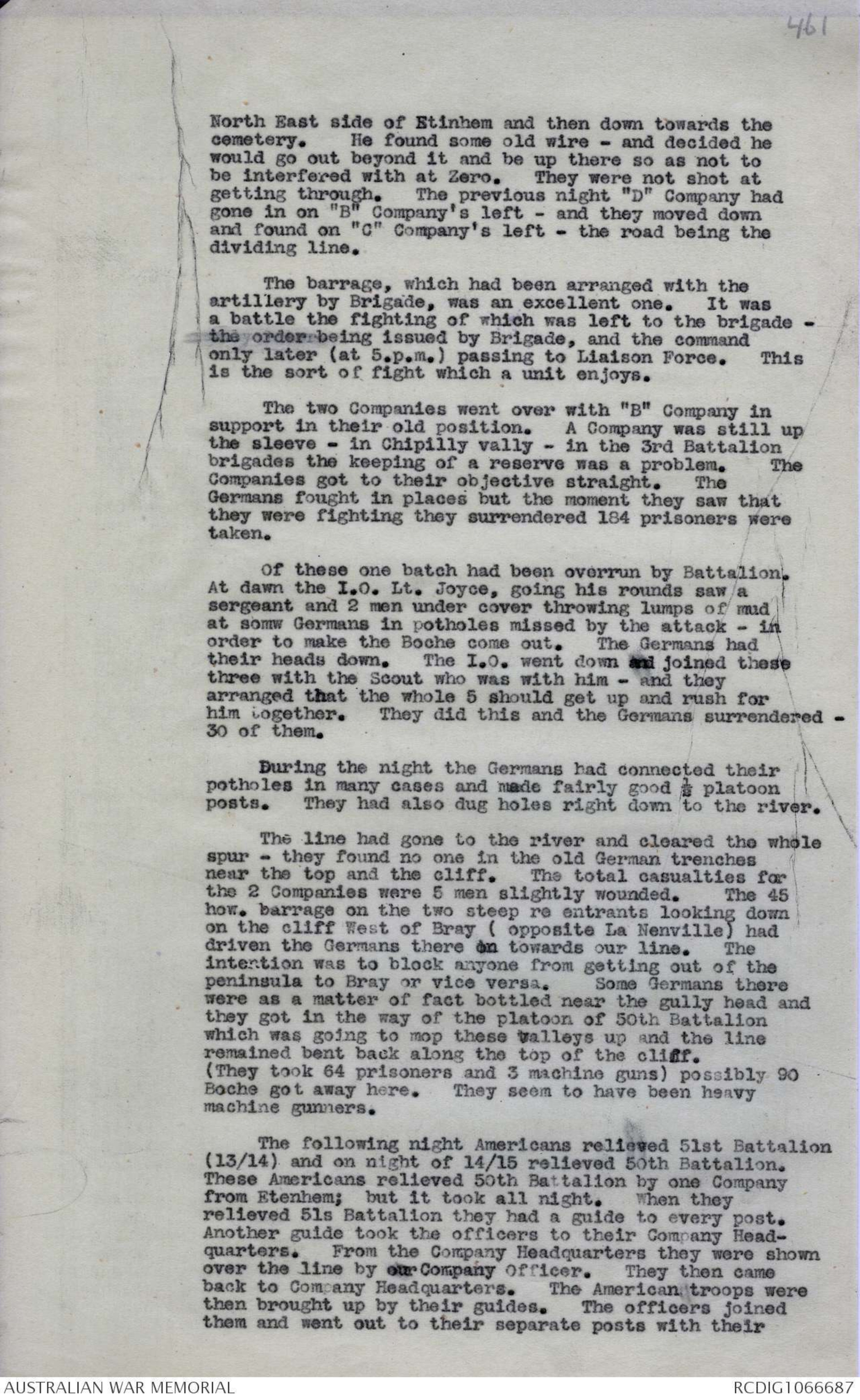
452
behind (this side of the Factory, 200 yards from the
cross roads. They reached there at 5 to 10. No.8
Platoon was a little way on the left of the road spread
out to cover about 60 yards and advancing in file as a
flank guard. A platoon of C Coy, was similarly on the
right of the road. The main part of the battalion was
then in single file (on each side of the roadway itself)
all in touch and proceeding down the road; The tanks
reached the starting point just at the right time and
came to the head of the column. They came one behind the
other the three close together the leading platoon was
in close tough with the rear tank.
They had hardily left the starting point when a
machine gun in the direction of Proyart about 1000 yards
away began to fire in their direction, firing high. It
seemed to them as if he heard the tanks. The enemy had
been quiet at the start (they had paused about 5 minutes
at La Flaque to make the final adjustments and it was 10
p.m. exactly the right time, when the tanks and trooy
had moved from La Flaque)
When the first machine gun opened the column kept
moving ahead. Immediately after that machine guns seemed
to start from both sides of the road. As they got along
the road machine guns closer to them opened Flares were
sent up and a great many of these were parachute flares
which hung in the air a long time, and lit the whole
country up. They got along the road about another 300
yards with this fire continuing - so McNicoll ordered the
leading tank to open fire with his 6 pounder on each side
of the road, with the idea of frightening the enemy. This
it did. The fire had now concentrated on the tanks and
sparks were flying off them as from a blacksmiths fire.
(Some of those behind wondered what they were and thought
that they were sparks from the machine guns of the tanks
until they realised the truth.
They passed the cross road in 27C, and kept on going
What McNicholl was looking out for was an avenue on the
right of the road which would show them where the Cross
Road at Avenue Cross was. He just thought he could make
out a line of trees to the right of the road when he was
hit. A runner had just previously come up and told him
that the battalion had been cut up and it was no use going
further. He had stopped the tanks. Just after that
he was hit.
They went no further. McNicholl at the front o f
the column had noticed shells passing overhead whizzing
not far above from an anti-tank gun down the road - they
could hear the bang of the gun The shells were fired
at the tanks but were a bit high and probably got the
rear of the column. The rear of the 37th had received
its first machine gun burst near La Flaque. There was
heavy shelling near the buildings at the Factory. The
head of the column did not get such heavy artillery fire.
Col. Knox Knight had moved up the road
past the men as they stopped, urging the men forward. He
went on to C Coy. when they were hold up, and shortly
after that he was hit by one of these shells.
The order of the company was:-
D---- C---- B----A----
Killed.
Col. Knox Knight
Lt. W. Roadknight, D. of W.
Wounded;
Lt. McNicoll, Lt. Smith.
453
PROYART, 21st 37th Battalion.
In the subsequent fight through Proyart on August
12th, Lieut. J.R. Kershaw was killed in the first attempt
to go bald headed for the railway during the earlier part
of the fight. He had left his platoon near the corner
of the village and was reconnoitering in front when he
was hit by a machine gun.
37th Battalion BRAY.
Held 35 Battalion on line west of Bray in L 14 and
C.
A
?C. D B
37 Battalion was on left of 40th. C Coy, was to
consolidate the Cross Roads at 16A1.9. A and B to pivot
on C and Connect. (This account is from one of the
officers who was in C Coy)
The Coy (C) only had 20 minutes (from the time when
orders were received by the Officers commanding the
companies at Battalion Headquarters) to get to the tape.
They had relieved that night and had not reconnoitred
the ground they were to fight on. Runners were sent
to get the company. C Company was then at the cutting
in 8C. "By the time we got the company, they had three
minutes left to get on to the tape" Capt. Cox, E. J.
went forward to reconnoître. He was to come back. As
they could not find him they got the company (Lt.
Robertson - who is the officer from whom this account
is obtained) and went out towards where he thought the
line would be. Doubling for weeds they got about 100 yards
Then they saw silhouetted
when our barrage opened.
against the bursts of the shells the figures on men on
their right front, whom Robertson to be the 40th
Battalion. They doubled for them and linked up with
them. And it turned out to be the 40th. So they
were exactly in their right place, luckily.
The Germans had opened a very heavy barage on the
banks and quarries down the road. They had to put
their gas masks on and attack for half an hour in gas
masks.
At the Cross Road they were held up by machine gun
fire from the front (coming from the old Goods sheds,
i.e. the fire came from there) They outflanked the
guns by working round the left. By the time they had
outflanked them a German S.O.S. signal went up 200 yards
in rear, in Bray Village. But the Germans did not put
down any barrage in answer to it. From there they went
on and got into position at the junction of the 5 roads
(one is not shown on the map, it runs east) All these
roads are sunken.
They captured that German machine gun and mounted
it, and then started to fire it obliquely over at their
right front, thinking that the Germans might take it for
their own gun firing at our men and that they might so get
some prisoners. Presently they saw a German coming
down the main road. The figure halted and started
calling out. They mimicked its tones. It came on and
turned out to be a German officer. He spoke English
and told them he had 28 men of machine gun section
across at L. C. Central. They planned an attack on these
Germans next morning, when they saw a party coming up
the road-8 men. They tried to dupe them also by
454
firing the machine gun obliquely. Ther Germans kept calling
thinking it was their own gun, and got to within about 40 yards on
Then they seemed to have a conception that all was the right.
not right, and turned across our right. We halted them and
they fired at us. We had 2 Lewis guns and a German gun all
trained on them - and killed three, and caught 5. Later in the
.night we got the ration carrier, just before breakfast. He was
carrying some stew. We gave the stew to the officer, and made
him tast it. He said it was right and we had a hot meal. The
stew carrier did not know whether to put his stew down and his
hands up or what to do when first he realised who we were.
The Germans put down a very heavy gas barrage on the left
companies, but not on C Company. That night 37 was held by
38 Battalion and moved to the southern edge of Bray by the
station. This was the same night about 9.p.m.
There was another attack, zero at 1.p.m. They attacked
with a heavy barrage as far as Ceylon Wood, - there was no
resistance in this attack at all. The only prisoners were prisoners
who had been caught in the barrage. Our supports went
along in lines of sections in fours in this attack.
CLERY 37th Battalion (from Capt. Heberle)
Capt Towl was on the right. Heberle was on the left in
St. Gond Trench. Towls orders were to proceed through Clery
and take up his position on the right of the ruins on the
Feuillacourt road (supposed to be a company headquarters of
ours- but that company was not in position) is company was to
stretch from there up to the junction of St. Gond Alley with
the C.T. leading to Avion trench. It had been reported that
Clery was taken. We found out after Towl had been through it
that it was not taken. Towl moved forward with his platoon and
had difficulty on account of this post on his right (on the knob
just East of Clery near the bridgehead) which was held by the
Germans, and also from the Germans in front. The fire from
this post made Towls party go further left and finally got them
down a little west of Avion trench, in the open - there were not
many shell holes, not far from a bit of high chalky ground (? on
their right front) A message came to Capt Heberle that Cox and
Willis were in a difficult situation but putting up a good fight.
There was no word of Towl. Heberle a sergeant and our men to
patrol through the village and get communication with Towl. That
left Heberle with only his company headquarters as he had sent
a platoon to help Willis and Cox. Heberle moved up and got
into the trench in rear (West) of Clery Copse. There he could
see Towl in difficulties. Towl had 2 Lewis gun teams and one
rifle section. About 14 men. He (?Heberle) found out that the
Strong point in Clery was occupied by the Germans. He took over
charge of C Company and got one Lewis Gunner to get his gun on
to the German post from his (Heberles) position and keep down
the gun in the strong point.
After that, Heberle was in the trench North of Berlingott
(?Berlingott North of Clery Copse) and got word to attack the
copse. He said it was impossible with the numbers he had, he
had very few. He had a company of the 40th Battalion sent up.
The 40th was to attack from the North East and Heberle from the
South West. 1 Later however he received orders from battalion
saying that he must watch the flank on the south as there was no
one there. For that reason he could not attack. The 40th
attacked he Copse from the Horth East, from the South West it
could not be done as they had to watch the flank. The 40th
Battalion had to come back, but men of theirs were found dead in
the copse, at any rate on the edge of it. The Germans followed
the 40th back at the time. 37 Battalion was stood to, but
the Germans did not come on far (Cox was captured, wounded) in
455
Cops)
Next morning 39 and 40 went through. At Anderson had the
platoon which Heberle sent up to support, and got little
further than St. Gonds trench. (Heberle could recognise Towl
by a peculiar wave of the hand to his Lewis Gunners)
Towl's report is with the diary and is a splendid one.
Heberle's map of this in my note book.
37th Battalion SUZANNE
(a sergeants essay)
Zero was postponed at midnight till 1.a.m. It had
been raining. Instructions to companies:- to clear
Susanne and press towards the Somme till definite resistance
was encountered. No Barrage. At West of village C Compang
came under harrassing artillery fire. Later, as it went
up the valley on left of Suzanne it came under machine gun
fire. At this point small patrols under Lieuts. Angus and
Robertson were sent forward. The rest of company under Cox
became reserve. Robertson's patrol pushed to within 30 yards
of the trenches covering Vaux Wood. A patrol under Ayeres
was coming up Robertson waited for them and when they arrived
they rushed the Germans Strong Point and found that the
trench in which it was, was at the junction with a Commun-
ication Trench running back to the main position in front
(West) of Vaux Wood. Robertsons party went along the trench
to the right driving any Germans who were there and captured
8 machine guns Ayers party rushed the position in the
communication trench and took a field gun and 4 Machine Guns.
There were only 14 men in these two parties together (Robert-
son and Ayers) A runner was sent for the reserves. As a
matter of fact the reserves had been coming along and were
then in the road running twoards Vaux Wood (the reserve
platoon and remaining details of company) They were within
200 yards of the captured position. They had 60 yards of
open to cross from the road to the trench, under machine gun
fire. Cox decided to attempt this, and the company was got
across at the double without a casualty.
It was now noon and they had been going 7 hours. The
flanks had been much slower. (39 and 11 Brigade) Nearly 2
hours C Company had an open flank. During this time the Ger-
mans shelled them fiercely, the fire ceasing when the others
came up.
The German guns were to the South West of Vaux Wood, 2
batteries. The Germans managed to get these away as the 37th
was unsupported. The company was very short of ammunition
attack. The ammunition came up before the last gun was got
clear and the Lewis Guns were turned onto the last limbers
as they disappeared round the North end of Vaux Wood. On
left of Vaux Wood was a small wood in which was a field gun.
A German driver tried to get this away- raced his team,
limbered up. But Lewis Guns brought team and rider down.
Germans got that gun away in night. It was a very brave
attempt of that driver. After dark the Germans got out of
and until it arrived they had to reserve it in case of
Vaux Wood. The trenches we had taken were 300 yards due west
an old 1915 trench system pitted with many shell holes.
(Heberles map of this is in my note book)
When the forward move from Susanne took place Sergeant
McRoh∧an, and was ordered to take out a party to scout and see
what the bridges were like at Vaux for 2nd Division. Also
"Curlu. He went out with 4 men and had rough time but returned
with his men and his report was acted on next day. 2nd Divisior
crossed there.(?)
456
37 Battalion was in 8 times at Somme. 3 against places
reported previously taken.
SKETCH - see original
457
BELLECOURT TUNNEL
September 29th, 1918.
Lt. Brown, Gas Officer of the 8th Brigade, visited
the Tunnel at Bellecourt on September 29th. He went
into it about 6.p.m. by one of the dugouts entrances in
which the 30th Battalion Headquarters was. He went to
look for gas apparatus at the same time having a general
look round -.
He found no gas, but a few Americans. They did
not know what was the position at the Northern entrance
of the Tunnel at this time. Some were asleep. In one
place there was an Office in charge. The men were tired
out, they had just got down the dugout and did not know
the position in the tunnel at all. He took them along
to their Commanding officer, but their Commanding Officer
did not anything. The Commanding Officer accompanied
him to Colonel Street (?).
The second time he went down was early in the afternoon
of September 30th. He got the idea that no one knew
what was on the left of the position and he though that
by getting through the Tunnel, out amongst the Germans
to the left, they might be able to bring back some useful
information or to try to find this out through the
Tunnel. He went along with an Electric Torch which he
shaded with his fingers. When they were about half
way through the Tunnel, he heard Machine gun fire overhead
in the open. He climbed up into another dugout. He
did not know whether it was out own people about or the
Germans. He heard voices, and for a time he though that
they were Germans. He put the light on one side and
went very cautiously. Getting nearer he found that they
were Americans in this dugout also, they did not know
anything about the Tunnel being below them at all either
to left or right. Brown told them it was as well to put
someone as Sentry. Their C.O. realised this at once.
He sent two officers with Brown along the Tunnel working
further North. There is no bend in the Tunnel. There
are three forts in the Tunnel one near the Southern
entrance built of concrete, another about the centre of
Bellecourt three quarters built. It blocks the whole
canal except its own occupants from firing there. Then
North of Bellecourt was a third in course of construction
From there you could see daylight looking North. It
looked like a little candlelight in the distance and got
bigger and bigger as they approached. Whilst they were
still on the way after the third Fort, after going some
distance along with the Americans, they could see day-
light fairly big ahead of them when all of a sudden it
disappeared. Just for a fraction of time Brown wandered
what it was, for he got the blast of an explosion and
heard the noise and they were knocked over. Some of the
staircases in the shafts were blown away. (There was one
every 1,000 yards). This made it very difficult for any-
one to be sure of escaping through the Tunnel if he got
cut off there. They were frightened that another mine
might blow up behind them if they waited and so they
cleared back along the tow path for all they were worth.
There are not many boats along that part. There is also
a big pumping machine gown there for pumping water up.
After the mine blew up there was no light down there - the
entrance was fairly blocked for it was all dark.
458
The third fort is nothing like half way along the
Tunnel and yet immediately after passing it they could
see daylight. Brown, therefore, understood that there
was no brake in the Tunnel.
Brown had his hand over the light so that he himself
was in shadow; the Germans probably saw the light coming along
and thought that we were attacking through the Tunnel, or
else, it might have been a chance that they blew it up just
then. The Americans were about half way. This party of
Americans had relieved another American Unit in the dugout
above. Below in the Tunnel there was nobody North of
Bellecourt.
---------------------.
459
13th Brigade and 51st Battalion.
August 8th Domart to Blangy Tronville.
spent day there.
August 9th Marched to Morcourt.
night there.
51st Battalion.
August 10th. Brigades gave verbal orders at 2.30 p.m.
on August 1Oth after a conference with Corps. Brigades
was at Morcourt. It was an attack for 9.30.p.m. same
night. Brigade Infantry officer and Battalion I.O's
went over North of Somme. No one at Division or
Corps knew who held Gressaire Wood.
Battalion crossed Somme fro first time about 7.p.m.
The Brigade I.O. after the orders had been issued
ascertained definitely the Americans were holding
Gressaire Wood. The Americans were up to the Cross
Roads at the North East end of Gressaire Wood and the
Wood North of this was clear of Germans and was possibly
held.
The tanks were to meet Battalions at the road
bend East of 17 Central. The tanks Battalion commander
came over in the afternoon and was told that his tanks
must meet an officer of 49th Battalion there, and then
the officer of 49th Battalion was to give them the tip
when to start. They were only to go up and down the
road and not fire - to make a noise and overawe the
Germans. They could fire a few grape shot down the
road the first trip - 49th Battalion was to go along
Bray Road and face North and East. 50 Battalion to go
up through Gressaire Wood and up the road to about
20 B 1.7. Then wheel right and face East.
They as a matter of fact did a movement opening out
fanwise and advanced across the open. It was pitch
dark.
51 Battalion was to send one Company to watch North
East exits of Etinhem with 4 vickers and 4 stokes guns
Lt. Finlason took his Company out. He followed 50
Battalion.
No barrage. It was a night operation with no
artillery - 4 Divisional Artillery was just pulling in.
Some of the guns were just in position.
9.35 Louch went outside the Brigade H.Q. in
Chipilly to listen for the rifle fire - and at 10 came
in and said there was no noise at all. At 50 Battalion
H.Q. no firing could be heard either, it was dark as pitch
no word coming back, everyone out of touch with the rear -
nad the Germans were gassing the woods. The Battalions
kept up on the high ground on the outskirts of the
wood - the top of the cliffs - and 49 Battalion hit off
between the woods to 18 Central (or there abouts) 51
Battalion followed the others in and dug in on the steep
slope in 29 A. Another Company went into dugouts in
29 B on the river side of the slope. The other
Company followed 50 Battalion across, and dug in as
sequired across the roads leading North East out of
Etinhem. Finlason trying to get contacttwith 50 Battalion
struck a party of Germans who ran. He was trying to
find the 50 Battalion on the heights due East of
460
Etinhem but they were not far down. He saw a party
what he took for 50 Battalion. He called to them
and heard someone speak in Herman and they dived one
say towards the cliff and he the other.
August 11th. As day rose this company moved down
towards Etinhem. The vickers guns and T.Ms. were all
in position waiting to get the Germans bottled. If
3rd Division had succeeded the Germans in Etinhem were
completely cut off Finlasons' Company moved down at
dawn to mop up the town and found only one German -
anything up to 300 Hermans were expected - and this one
alone was found. No doubt Germans had got away in the
dark. There was a partially destroyed bridge between
Etinhem and the Mericourt spur.
"B" Company dug in between the village and the
river around South end of village. They were in the
trees there very well hiden; and in spite of the shelling
of Etinhem they did not lose a man in the two days.
About dawn? it was known that the 3rd Division had failed.
About 11.a.m. Cpl. Coulter the Brigade Scout came
in and said he had seen Germans at about 32 Central -
digging in. Between then and 1.p.m. there was a continuous
argument as to whether these were Germans or no.
General Burgess saw them about 12 and thought they were.
About 12.30 Col. Christie went up and he decided that
they were Germans.
This Was August 11th.
That afternoon, at once, Col. Christie told the
Company (Finlasons) to send out a patrol and get what
information he could. This patrol made it certain that
they were Germans. The position was rather enxious at
the time on account of the possibility of an attack from
the North East.
There was a German gun behind the height in
9 Central enfilading them right up the trench. They
were also being heavily strafed from East of Bray
(Cerglon Wood) That morning a gun in Cateau Wood also
was firing into them - our batteries had got on to him
and this gun was silenced by about 2.p.m. Col.
Williams 10 Brigade of A.F.A. was working with the
13th Brigade (it was grouped with 11th Brigade A.F.A.)
Williams was living with 15th Brigade and the liaison
was very good. One good senior officer in liaison is
better than a lot of juniors.
A shoot was arranged - which was pretty heavy - one
battery getting right onto the Germans with H.E. and
shrapnel. By that time the Germans had some cover
in their potholes.
August 12th
On the morning of August 12th the
3rd Division (11th Brigade) had attacked and were working
(atdawn) through Cateau Wood. At 11.a.m. a conference
was held at 13th Brigade H.Qrs. in Chipilly valley and
an attack was planned for that night. It was planned
at first for 11.p.m. and then postponed to 1.p.m.
Division asked for this as a relief was going on South of
the Somme, and they did not want it strafed. It was a
pitch black night but fine.
After dark the Company which was in dugouts ("C"
Company Capt. Harburn) on the cliff side moved round the
461
North East side of Etinhem and then down towards the
cemetery. He found some old wire - and decided he
would go out beyond it and be up there so as not to
be interfered with at Zero. They were not shot at
getting through. The previous night "D" Company had
gone in on "B" Company's left - and they moved down
and found on "C" Company's left - the road being the
dividing line.
The barrage, which had been arranged with the
artillery by Brigade, was an excellent one. It was
a battle the fighting of which was left to the brigade
the order being issued by Brigade, and the command
only later (at 5.p.m.) passing to Liaison Force. This
is the sort of fight which a unit enjoys.
Tho two Companies went over with "B" Company in
support in their old position. A Company was still up
the sleeve - in Chipilly vally - in the 3rd Battalion
brigades the keeping of a reserve was a problem. The
Companies got to their objective straight. The
Germans fought in places but the moment they saw that
they were fighting they surrendered 184 prisoners were
taken.
Of these one batch had been ovorrun by Battalion.
At dawn the I.O. Lt. Joyce, going his rounds saw a
sergeant and 2 men under cover throwing lumps of mud
at somw Germans in potholes missed by the attack - in
order to make the Boche come out. The Germans had
their heads down. The I.O. went down and joined those
three with the Scout who was with him - and they
arranged that the whole 5 should get up and rush for
him together. They did this and the Germans surrendered -
30 of them.
During the night the Germans had connected their
potholes in many cases and made fairly good ½ platoon
posts. They had also dug holes right down to the river.
The line had gone to the river and cleared the whole
spur - they found no one in the old German trenches
near the top and the cliff. The total casualties for
the 2 Companies were 5 men slightly wounded. The 45
how. barrage on the two steep re entrants looking down
on the cliff West of Bray (opposite La Nenville) had
driven the Germans there on towards our line. The
intention was to block anyone from getting out of the
peninsula to Bray or vice versa. Some Germans there
were as a matter of fact bottled near the gully head and
they got in the way of the platoon of 50th Battalion
which was going to mop these valleys up and the line
remained bent back along tho top of the cliff.
(They took 64 prisoners and 3 machine guns) possibly 90
Boche got away here. They seem to have been heavy
machine gunners.
The following night Americans relieved 51st Battalion
(13/14) and on night of 14/15 relieved 50th Battalion.
These Americans relieved 50th Battalion by one Company
from Etenhem; but it took all night. When they
relieved 51s Battalion they had a guide to every post.
Another guide took the officers to their Company Head-
quarters. From the Company Headquarters they were shown
over the line by our Company Officer. They then came
back to Company Headquarters. The American troops were
then brought up by their guides. The officers joined
them and went out to their separate posts with their
 Sam scott
Sam scottThis transcription item is now locked to you for editing. To release the lock either Save your changes or Cancel.
This lock will be automatically released after 60 minutes of inactivity.